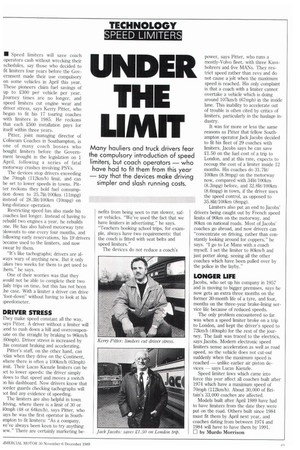ER
Page 65

If you've noticed an error in this article please click here to report it so we can fix it.
• Speed limiters will save coach operators cash without wrecking their schedules, say those who decided to fit limiters four years before the Government made their use compulsory on some vehicles in April this year. These pioneers claim fuel savings of up to £300 per vehicle per year. Journey times are no longer, and speed limiters cut engine wear and driver stress, says Kerry Fitter, who began to fit his 17 touring coaches with limiters in 1985. He reckons that each £500 installation pays for itself within three years.
Fitter, joint managing director of Coliseum Coaches in Southampton, is one of many coach bosses who bought limiters before the Government brought in the legislation on 1 April, following a series of fatal motorway crashes involving PSVs.
The devices stop drivers exceeding the 70mph (112km/h) limit, and can be set to lower speeds in towns. Fitter reckons they hold fuel consumption down to 25.71ff/100km (11mpg) instead of 28.31it/100km (10mpg) on long-distance operation.
Restricting speed has also made his coaches last longer. Instead of having to rebuild two engines a year, he rebuilds one. He has also halved motorway tyre blowouts to one every four months, and following early reservations, his 19 drivers became used to the limiters, and now swear by them.
"It's like tachographs; drivers are always wary of anything new. But it only Lakes two weeks for them to get used to them," he says.
One of their worries was that they would not be able to complete their two laily trips on time, but this has not been he case. With a limiter a driver can drive `foot-down" without having to look at his speedometer.
DRIVER STRESS
They make speed constant all the way, says Fitter. A driver without a limiter will Lend to rush down a hill and overcompensate on the straight by braking to 96km/h :60mph). Driver stress is increased by his constant braking and accelerating. Pitter's staff, on the other hand, can relax when they drive on the Continent, where there is often a 100km/li (63mph) imit. Their Lucas Kienzle limiters can be ;et to lower speeds: the driver simply ;lows to that speed and moves a switch )fl his dashboard. Now drivers know that )order guards checking tachographs will lot find any evidence of speeding. The limiters are also helpful in town lriving, where there is a limit of 30 or tOmph (48 or 64km/h), says Fitter, who ;ays he was the first operator in Southimpton to fit limiters: "As a company, we've always been keen to try anything iew." There are certainly marketing be nefits from being seen to run slower, safer vehicles. "We've used the fact that we have limiters in advertising," he says. "Teachers booking school trips, for example, always have two requirements: that the coach is fitted with seat belts and speed limiters."
The devices do not reduce a coach's power, says Fitter, who runs a mostly-Volvo fleet, with three Kassbohrers and five MANs. They restrict speed rather than revs and do not cause a jolt when the maximum speed is reached. His only complaint is that a coach with a limiter cannot overtake a vehicle which is doing around 107km/h (67mph) in the inside lane. This inability to accelerate out of trouble is often cited by critics of limiters, particularly in the haulage industry.
It was for more or less the same reasons as Pitter that fellow Southampton operator Jack Jacobs decided to fit his fleet of 29 coaches with limiters. Jacobs says he can save £1.50 on the fuel cost of a trip to London, and at this rate, expects to recoup. the cost of a limiter inside 12 months. His coaches do 31.7fit/ 100km (8.9mpg) on the motorway now, compared with 341it/100km (8.3mpg) before, and 32.81k/100km (8.6mpg) in town, if the driver uses the speed control, as opposed to 35.8lit/I0Okm (8mpg).
Limiters also put an end to Jacobs' drivers being caught out by French speed limits of 90km on the motorway, and 801un on national roads. Most of Jacobs' coaches go abroad, and now drivers can "concentrate on driving, rather than constantly looking around for coppers," he says. "I go to Le Mans with a coach myself. I set the limiter to 80km/h and just potter along, seeing all the other coaches which have been pulled over by the police in the layby."
LONGER LIFE
Jacobs, who set up his company in 1957 and is moving to bigger premises, says he now gets an extra three months on the former 30-month life of a tyre, and four, months on the three-year brake-lining service life because of reduced speeds.
The only problem encountered so far was when a speed limiter broke on a trip to London, and kept the driver's speed to 72km/h (40mph) for the rest of the journey. The fault was traced to the electrics, says Jacobs. Modern electronic speed limiters sense acceleration as well as road speed, so the vehicle does not cut-out suddenly when the maximum speed is reached — unlike earlier air piston devices — says Lucas Kienzle.
Speed limiter laws which came into force this year affect all coaches built after 1974 which have a maximum speed of 70mph (112km/h). About 30,000 of Britain's 33,000 coaches are affected.
Models built after April 1989 have had to have limiters from the date they were put on the road. Others built since 1984 must fit them by April next year, and coaches dating from between 1974 and 1984 will have to have them by 1991.
by Murdo Morrison
















































































































